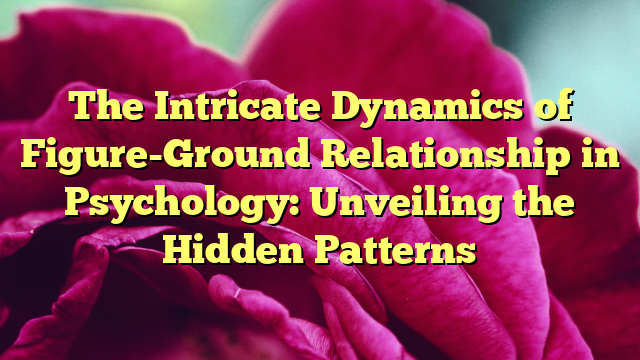The Intricate Dynamics of Figure-Ground Relationship in Psychology: Unveiling the Hidden Patterns
The Intricate Dynamics of Figure-Ground Relationship in Psychology: Unveiling the Hidden Patterns
Introduction
The figure-ground relationship is a fundamental concept in psychology that refers to the way our brains distinguish between objects and their background. It is a crucial aspect of perception, as it allows us to make sense of the world around us. However, the dynamics of this relationship are far more complex than they may seem at first glance. In this article, we will explore the intricate dynamics of figure-ground relationship in psychology and unveil the hidden patterns that underlie this process.
The Basics of Figure-Ground Relationship
At its core, the figure-ground relationship is a process of visual segregation. When we look at an image, our brains automatically separate the objects in the foreground (the figure) from the background (the ground). This process is essential for our ability to perceive and understand the world around us.There are several factors that influence the figure-ground relationship, including contrast, size, and shape. For example, objects that are larger or have a higher contrast with their background are more likely to be perceived as the figure. Similarly, objects with a distinct shape or contour are more likely to be perceived as the figure.
The Role of Attention in Figure-Ground Relationship
While the basic principles of figure-ground relationship are relatively straightforward, the process is far more complex than it may seem. One of the key factors that influence this relationship is attention. Our brains are constantly filtering out irrelevant information and focusing on what is most important. This means that the figure-ground relationship is not static but rather dynamic and constantly changing.For example, imagine you are walking down a busy street. Your attention is focused on the people and objects in front of you, and the background fades into the periphery of your vision. However, if something in the background suddenly becomes relevant (such as a car honking or a person shouting), your attention will shift, and the background will become the figure.
The Gestalt Principles of Figure-Ground Relationship
Another important aspect of the figure-ground relationship is the Gestalt principles. These principles are a set of rules that describe how our brains organize visual information. They are based on the idea that our brains are wired to perceive patterns and organize information into meaningful wholes.The Gestalt principles play a significant role in the figure-ground relationship. For example, the principle of proximity states that objects that are close together are perceived as a group. This means that if several objects are close together in the foreground, they will be perceived as a single figure, while the background will be perceived as a single ground.
The Hidden Patterns of Figure-Ground Relationship
While the basic principles of figure-ground relationship are well understood, there are still many hidden patterns that underlie this process. One of the most interesting of these patterns is the way our brains use context to determine the figure-ground relationship.Context refers to the information surrounding an object. For example, imagine you are looking at a picture of a tree. If the tree is surrounded by other trees and foliage, it will be perceived as part of the background. However, if the tree is surrounded by a clear blue sky, it will be perceived as the figure.This context-dependent nature of the figure-ground relationship is essential for our ability to perceive and understand the world around us. It allows us to filter out irrelevant information and focus on what is most important.
Conclusion
The figure-ground relationship is a fundamental concept in psychology that plays a crucial role in our ability to perceive and understand the world around us. While the basic principles of this relationship are well understood, the process is far more complex than it may seem at first glance. By exploring the intricate dynamics of figure-ground relationship in psychology, we can gain a deeper understanding of the hidden patterns that underlie this process.

